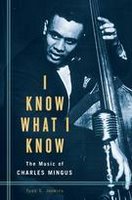
I Know What I Know: the Music of Charles Mingus
By Todd S. Jenkins (Forward by Sy Johnson)
Praeger
0-275-98102-9
In some ways Charles Mingus might be too good a subject for biographers. He was truly a larger than life figure about whom there are scores of stories purporting to document his eccentricity. It is easy to lose sight of the music of Charles Mingus which should be the primary interest of anyone reading a book on Mingus. To rectify that, Todd Jenkins wrote I Know What I Know, a full analysis of Mingus’ music, recording by recording.
In general, Jenkins eschews the biographical details of his subject’s life, except in so far as they illuminate a particular piece of music under discussion. He does however, note the bassist’s troubles with the local musicians’ union when Mingus came to New York in 1951 with vibist Red Norvo. As Jenkin relates:
“The city’s Musicians Union wouldn’t let Norvo work in its clubs if he retained the bassist, ostensibly because Mingus didn’t have a local union card. But the race issue was an unspoken yet implicit factor, so Norvo reluctantly let Mingus go.” (p. 17)
However, Mingus would not take such an action laying down, would sue the union, ultimately settling out of court. He would use the financial compensation to start one of his several record labels, Debut.
Mingus was famously political, and spoke out often in support of civil rights. Many of his song titles had ungainly political titles, that bordered on parody, like: “Free Cell Block F, ‘Tis Nazi USA” and “Once Upon a Time There Was a Holding Corporation Called Old America.” Wisely though, Jenkins focuses on Mingus the composer and musician, and sometimes the person, as when longtime sideman Charles McPherson remembers an early gig with Mingus at a fundraiser for his friend poet Kenneth Patchen. McPherson recalls:
“Charles did it for nothing but did want to pay us. So at the end of the benefit, after we performed, Mingus began doling out five-dollar bills to the players. I turned it down and told him to put it in the basket for Patchen. What’s five dollars going to do for me? I can buy a couple of beers with it, but this is a benefit. Then Mingus looked at me and his eyes welled up. From that point on I could do no wrong in the band.” (p. 79)
Though Mingus and many of his great sidemen have passed on, Jenkins has captured some valuable recollections from surviving band members, like McPherson and Jack Walrath. He is at his best when describing the music itself, as when he discussing Mingus’ 1964 band’s Town Hall Concert (on Fantasy/OJC), likening Dolphy’s solo to “a drunken ice-cream truck, constantly teetering back and forth between tonality and freedom.” (p. 108)
One odd aspect of I Know What I Know are some comments made by the author about Sue Graham Mingus, the widow of Charles Mingus, which could be construed as less than flattering. In an introductory note Sue Mingus cautions readers about shoddy bootlegs, arguing: “Not only are musicians and record companies cheated out of royalties, but their reputations are damaged when consumers purchase poor qualities of their work,” noting that “some of the Mingus material discussed in this book falls within that category.” (p. xvi)
Later, Jenkins writes: “’The I of Hurricane Sue’ was composed for his wife, Sue Graham Mingus, and it is as complex a creation as the both of them. Mingus maintained that it was a tribute but not a reflection of her personality; one might have guessed otherwise.” (p. 135) Comparing Sue Mingus to a hurricane seems a bit tactless, especially given her dedication to Mingus, his music, and even Jenkins' book. Her book Tonight at Noon is recommended for additional perspective on their relationship. Regardless, Sue Mingus has a point that artists deserve to be compensated fairly for the music they create, which does not happen when their work is pirated.
While Jenkins is not the smoothest writer, he brings some fresh insight to Mingus’ music. I Know What I Know serves as a set of liner notes to his collected recorded output. In doing so, it takes the focus away from colorful Mingus stories, and puts it back where it belongs, on the music.